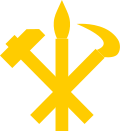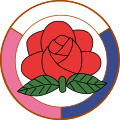Top Qs
Timeline
Chat
Perspective
Democratic Front for the Reunification of Korea
North Korean popular front From Wikipedia, the free encyclopedia
Remove ads
The Democratic Front for the Reunification of Korea (DFRK), also known as the Democratic Front for the Reunification of the Fatherland (DFRF) or the Fatherland Front, was a North Korean united front formed on 25 June 1949 and led by the Workers' Party of Korea (WPK).[1] It was initially called the Fatherland United Democratic Front.
The front initially consisted of 72 parties and social organizations from both the North and the South; at the time of its dissolution, it had 24 members.[2][3] The three legal political parties of North Korea—the WPK, the Korean Social Democratic Party, and the Chondoist Chongu Party—all participated in the front.[4] The country's four most important mass organizations—the Socialist Patriotic Youth League, Socialist Women's Union of Korea, General Federation of Trade Unions of Korea, and Union of Agricultural Workers of Korea—were member organizations.[5][6] The Korean Children's Union was also a member organization.[7]
All candidates for an elected office in North Korea had to be a member of the front, and were nominated and approved at mass meetings held by the front.[8] The WPK led the front and all other member organizations were subservient to it.[9] The WPK was thus able to predetermine the composition of the Supreme People's Assembly (SPA). The Anti-Imperialist National Democratic Front is ostensibly the South Korean counterpart to the DFRK, but it operates from North Korea.
Remove ads
History
Summarize
Perspective

The National Democratic Front (민주주의민족전선), a South Korean leftist organization, was founded with the Communist Party of Korea as its leading organization on 15 February 1946. It was formed from 40 leftist parties and consisted of 398 communists led by Lyuh Woon-hyung, Pak Hon-yong, and Ho Hon. The North Korean National Democratic Front (북조선 민주주의 민족통일전선) was founded on 22 July 1946.[10] It was formed from 13 parties and organizations and led by Kim Il Sung, Kim Tu-bong, and Choe Yong-gon. It included the North Korean Branch of the Communist Party and the New People's Party of Korea, which were soon merged to form the Workers' Party of North Korea, as well as the Korean Democratic Party and the Chondoist Chongu Party.[11] The North Korean National Democratic Front absorbed the South Korean National Democratic Front on 25 June 1949, after South Korea outlawed the latter, leading to the establishment of the Fatherland United Democratic Front.[12][11]
In the 1950s, the front outlived its original role as a way for the Workers' Party to consolidate its power. It was therefore assigned a new role; to serve as body to interact with South Korean organizations and political parties. It consequently changed the English rendering name to the Democratic Front for the Reunification of Korea (DFRK). According to North Korea expert Andrei Lankov, in this capacity, the DFRK "handled relations with South Korea's assorted progressive groups while also serving as a quasi-official voice of the North Korean government on matters related to the South".[11]
In 2018, the DFRK was led by Pak Myong Chol.[13] Presidium members during that time included Ri Kil Song and Kim Wan Su.[14] On 23 March 2024, the Korean Central News Agency reported that the DFRK had officially dissolved its central committee, effectively dissolving the whole front. The move followed a speech by Kim Jong Un in which he stated that the North would give up its goal of peaceful reunification with the South and dissolve all organizations related to the goal.[15] At the time of its dissolution, the Director of the Secretariat of the Central Committee of the DFRK was Maeng Kyong Il. Members of the Presidium of the Central Committee included Pak Myong Chol and Kim Wan Su.[16]
Remove ads
Member organizations
In the SPA
With SPA observer status
Remove ads
Electoral history
Supreme People's Assembly elections
See also
Notes
References
Further reading
Wikiwand - on
Seamless Wikipedia browsing. On steroids.
Remove ads






